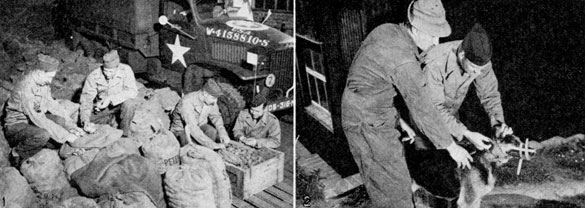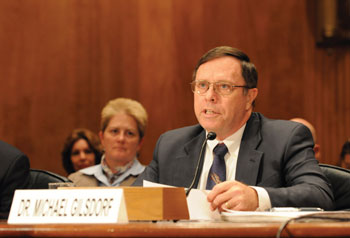Association of federal veterinarians marks centennial
The National Association of Federal Veterinarians this year marks a century of advocating for veterinarians working for the federal government.
The NAFV was formed in 1918 during the AVMA annual meeting in Philadelphia by a handful of veterinarians with the Bureau of Animal Industry under the Department of Agriculture. Most veterinarians who worked for the bureau could not afford to join professional associations or purchase scientific journals and, thereby, stay current on the latest developments in veterinary medicine.

"They were so poorly paid they often could not save any money for emergencies and most of them lived from week to week, barely getting by," according to a history of the NAFV.
The NAFV was created to elevate "the veterinary profession, thereby winning for it public respect, confidence and understanding of the important work it performs." Additional goals included identifying career opportunities for promising young veterinarians, studying and working to improve the salaries and incomes of veterinarians, and maintaining a high standard of veterinary education.
The "Bureau Veterinarian" newsletter—now the "Federal Veterinarian"—was first published in 1922 and continues today. The newsletter provides NAFV members with a summary of the important events and activities in public veterinary practice and management, and it also serves as a written voice of federal veterinarians.
Since its creation, the NAFV has grown its membership roster to 1,743 current and retired federal veterinarians. That's down from a peak of 2,200 in 1975.
Members of the NAFV work across federal government agencies, from the Department of Agriculture and the National Institutes of Health to the Department of Defense and the U.S. Agency for International Development. They bring their unique knowledge and skills to bear on a wide range of animal and public health programs, including ones on food safety, humane slaughter and transportation, veterinary biologics, wildlife disease surveillance, the import/export of live animals and animal products, and the health and welfare of animals used for research and exhibited at zoos and aquariums.
Federal veterinarians are a vital public resource in preventing both animal and human diseases and in feeding the world, and NAFV is their champion.
Dr. Larry Davis, president, National Association of Federal Veterinarians
"It is exciting to know that veterinarians have been officially involved with animal and public health for 100 years. NAFV is proud of its accomplishments and proud of the accomplishments of the federal veterinarian," said association president Dr. Larry Davis, a district manager with USDA Food Safety and Inspection Service.
The organization remains committed to advocating for its members, most of whom are employed by the USDA. "NAFV is the only association that focuses on federally employed veterinarians and speaks and works specifically for them," explained Dr. Michael Gilsdorf, who stepped down as the organization's executive vice president this past April after serving 11 years.

Historically, the NAFV has always enjoyed a close relationship with the AVMA. "We partner with the AVMA on issues affecting federal veterinarians and inform other veterinary associations, industry, and the public about the important work federal veterinarians do," Dr. Gilsdorf said.
One of the two NAFV annual general membership meetings is held concurrently with the AVMA Annual Convention. The NAFV is also a constituent allied veterinary organization represented in the AVMA House of Delegates. In 1975, NAFV delegate Dr. Lois Hinson became the first female delegate in the HOD. Two years later, the NAFV and Mississippi VMA endorsed Dr. Bobbye Chancellor for AVMA vice president, the first woman elected to a major office in the AVMA.
The USDA has an official management relationship with the NAFV, which the department recognizes as the representative organization for federally employed veterinarians. This recognition authorizes the association to represent all federal veterinarians in resolving issues affecting USDA agency operations, programs, and employees as well as to improve the effectiveness of supervisors and managers.
The NAFV consults with the USDA Animal and Plant Health Inspection Service and the FSIS regarding management and supervisory issues to enhance agency operations and working conditions, communication, and managerial effectiveness, and to establish policies that best serve the public interest in accomplishing the agency's mission.
To accomplish this, the NAFV has representatives across the nation who meet with federally employed veterinarians and gather their thoughts, suggestions, and concerns on major and minor issues. Minor issues are discussed by NAFV local representatives, while major issues are taken up with agency leaders. The NAFV recommends solutions to the issues it brings to the department.
Additionally, the NAFV works with other associations and Congress to protect agency budgets and positions, improve working conditions, support training and continuing education opportunities, improve involvement in agency programs, and protect benefits and pay for federal veterinarians.
"Federal veterinarians are a vital public resource in preventing both animal and human diseases and in feeding the world, and NAFV is their champion," Dr. Davis said.
The NAFV's president-elect, Dr. Barbara Porter-Spalding, said the association must remain relevant to federal veterinarians by helping fight for specialty pay; maintaining veterinary leadership of organizations dedicated to food hygiene, disease eradication, veterinary biologics, and antimicrobials; and engaging with the increasing number of veterinarians who serve in Congress.
Dr. Porter-Spalding, a swine and emergency epidemiologist with APHIS Veterinary Services, believes public health veterinarians will have more opportunities and influence with the rise of the one-health movement.
"Antimicrobial resistance, zoonotic and vector-borne disease control, and environmental health issues will all be tackled by the future public practice veterinarian," she said. "NAFV will adapt to stay relevant for these federal practitioners as well, as we recruit more of them into our ranks."
Related JAVMA content:
Problems persist with federal veterinary workforce numbers (Aug. 1, 2015)
Partnership promotes veterinary careers in public and corporate practice (April 1, 2014)
LEGENDS: America's first DVM (March 1, 2013)
The voice of the federal veterinarian (Oct. 15, 2007)